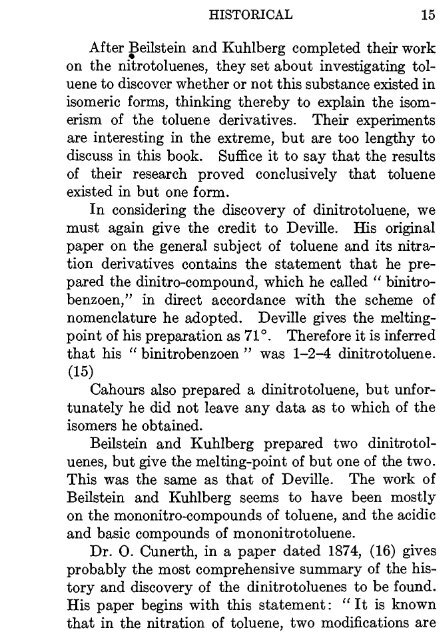TNT: Trinitrotoluenes and Mono and Dinitrotoluenes
TNT: Trinitrotoluenes and Mono and Dinitrotoluenes
TNT: Trinitrotoluenes and Mono and Dinitrotoluenes
You also want an ePaper? Increase the reach of your titles
YUMPU automatically turns print PDFs into web optimized ePapers that Google loves.
HISTORICAL 15<br />
After Beilstein <strong>and</strong> Kuhlberg completed their work<br />
on the nitrotoluenes, they set about investigating toluene<br />
to discover whether or not this substance existed in<br />
isomeric forms, thinking thereby to explain the isomerism<br />
of the toluene derivatives. Their experiments<br />
are interesting in the extreme, but are too lengthy to<br />
discuss in this book. Suffice it to say that the results<br />
of their research proved conclusively that toluene<br />
existed in but one form.<br />
In considering the discovery of dinitrotoluene, we<br />
must again give the credit to Deville. His original<br />
paper on the general subject of toluene <strong>and</strong> its nitration<br />
derivatives contains the statement that he prepared<br />
the dinitro-compound, which he called " binitrobenzoen,"<br />
in direct accordance with the scheme of<br />
nomenclature he adopted. Deville gives the meltingpoint<br />
of his preparation as 71°. Therefore it is inferred<br />
that his " binitrobenzoen " was 1-2-4 dinitrotoluene.<br />
(15)<br />
Cahours also prepared a dinitrotoluene, but unfortunately<br />
he did not leave any data as to which of the<br />
isomers he obtained.<br />
Beilstein <strong>and</strong> Kuhlberg prepared two dinitrotoluenes,<br />
but give the melting-point of but one of the two.<br />
This was the same as that of Deville. The work of<br />
Beilstein <strong>and</strong> Kuhlberg seems to have been mostly<br />
on the mononitro-compounds of toluene, <strong>and</strong> the acidic<br />
<strong>and</strong> basic compounds of mononitrotoluene.<br />
Dr. 0. Cunerth, in a paper dated 1874, (16) gives<br />
probably the most comprehensive summary of the history<br />
<strong>and</strong> discovery of the dinitrotoluenes to be found.<br />
His paper begins with this statement: "It is known<br />
that in the nitration of toluene, two modifications are
















